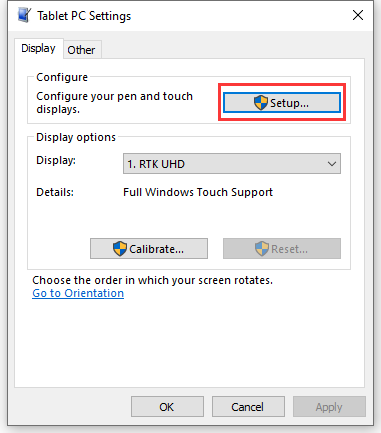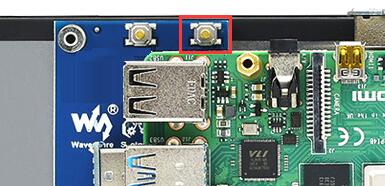11.9inch HDMI LCD
| ||
Overview
Introduction
This is an 11.9-inch Capacitive Touch Screen LCD, IPS screen, which supports Raspberry Pi and can also be used as a computer monitor.
| More |
Features
- 11.9inch IPS screen, 320 x 1480 resolution.
- 5-point capacitive touch control, tempered glass panel, hardness up to 6H.
- Use with Raspberry Pi, supports Raspberry Pi OS / Ubuntu / Kali and Retropie system.
- Use as a computer monitor, it supports Windows 11 / 10 / 8.1 / 8 / 7 system.
- HDMI audio input, 3.5mm headphone/speaker jack.
EDID Timing Parameters
If the system of the main control board can automatically recognize the EDID for display, there is no need to set the relevant timing parameters additionally.
Otherwise, you can refer to the following EDID settings:
| Pixel Clock | H Addressable | H Blanking | V Addressable | V Blanking | H Front Porch | H Sync Width | V Front Porch | V Sync Width | H Image Size | V Image Size | H Border | V Border |
|---|---|---|---|---|---|---|---|---|---|---|---|---|
| 48.00 | 320 | 200 | 1480 | 76 | 100 | 10 | 60 | 10 | 320 | 1480 | 0 | 0 |
Working with PC
This LCD supports Windows 7/8/8.1/10/11 system:
1. Connect the TOUCH interface of the LCD to the USB interface of the PC. Waiting for a moment, The touch will be recognized by Windows automatically.
2. Connect the HDMI interface of the LCD to the HDMI port of the PC. About 10 seconds later, you can see that the LCD properly. If you need to output sound, you can connect to 3.5mm headphones through an HP audio output port.
Note:
1) When the computer is connected to multiple monitors at the same time, the touch effect of the 7-inch LCD will be applied to the main screen by default. If you need to specify the touch to the secondary screen, see #Calibration touch on Win 10 PC
2)Sometimes LCD will flicker because of undersupplying from the USB cable of the PC. You need to connect an external power supply (5V/2A) to the DC port.
Calibration touch on Win 10 PC
Take the windows10 system as an example:
- 1. Enter the Windows settings of the system, type in the search bar and click "Calibrate the screen for pen or touch input" (as shown in the picture below).
- 2. Click "Setup" in the pop-up "Tablet PC Settings" interface:
- 3. The following text prompt will appear on the screen. Please tap the touch screen with your finger, and the computer will recognize it as a touch screen.
【Note】If the touch screen is blank, press the "Enter" key, and the text prompt will switch to the touch screen. (The screen which displays the text prompt will be used as a touch screen!)
Working with Raspberry Pi
This LCD supports Raspberry Pi OS/Ubuntu Mate/Kali/Retropie/Windows 10 IoT Core.
Please download the latest version of the image on the Pi official website.
- 1) Download the compressed file to the PC, and unzip it to get the .img file.
- 2) Connect the TF card to the PC and use SDFormatter to format the TF card.
- 3) Open the Win32DiskImager software, select the system image prepared in step 1, and click write to burn the system image
- 4) After the image has finished writing, open the config.txt file in the root directory of the TF card, add the following code at the end of config.txt, then save and quit the TF card safely.
max_framebuffer_height=1480 hdmi_group=2 hdmi_mode=87 hdmi_timings=320 0 80 16 32 1480 0 16 4 12 0 0 0 60 0 42000000 3
You must make sure that there are no spaces on either side of the equal sign.
- 5) Insert the TF card into the Raspberry Pi
- 6) Connect the Touch interface of the LCD to the USB port of Raspberry Pi.
- 7) Connect the HDMI interface of the LCD to the HDMI port of Raspberry Pi and then power on the Raspberry Pi, it can display normally after waiting for about a few seconds.
Note:
- The screen is displayed vertically by default. For convenience, you can adjust the display orientation of the screen, see #Orientation setting(Working with Raspberry Pi).
- When the Raspberry Pi is connected to multiple monitors at the same time, the touch effect of the 7-inch LCD will be applied to the main screen by default. If you need to specify the touch to the secondary screen, see#Calibrate double-touchscreen in Pi 4
Orientation setting(Working with Raspberry Pi)
Display orientation
If you are using the Raspberry Pi4, you can use the following method to rotate the display direction.
- 1. Open Screen Configuration.
- 2. Set the rotation as shown below.
- 3. And then after rotating the touch direction, the LCD will work normally.
If you are using Pi3+ or an older version, you can rotate the display direction in the following ways:
- 1. To rotate the display, you can append this statement to the config file.
display_rotate=1 #1: 90; 2: 180; 3: 270
- 2. Reboot the Raspberry Pi.
sudo reboot
Touch orientation
After the display is rotated, the position of the touch is incorrect because the touch doesn't change with the display angle. So the touch also needs to be modified. You can hold the following button for 5s to change the touch direction.
【Note】When using the new system, it may cause touch reverse errors. At that time, you need to press and hold "Rotate Touch" to rotate.
Set the Screen Always On
Some customers want to display without being affected by the screen saver function which can be set as follows. Turn off the screen saver.
Open lightdm.conf.
sudo nano /etc/lightdm/lightdm.conf
Change lightdm.conf to find "xserver-command" under the [SeatDefaults] section, uncomment it, and change it to read as follows:
#xserver-command=X
Modify to
xserver-command=X -s 0 -dpms
-s # –: Set the screen saver not to enable.
dpms: Disable power saving management.
Reboot:
sudo reboot
Set the Screen Off and On
Users can set the screen to turn off and on with the following commands.
vcgencmd display_power 0 vcgencmd display_power 1
Calibrate double-touchscreen in Pi 4
- 1. Open the terminal and input the command: xrandr to check the HDMI ID of the main monitor. (It is HDMI-1 most time);
- 2. Input the command xinput in the terminal, and check the touch ID of the main monitor. (There should be two IDs, you can touch displays to check which is the main one);
- 3. Run the command: xinput map-to-output <touch ID> <HDMI-ID>
(Don't forget to change the ID to the correct one just like: xinput map-to-output 7 HDMI-1)
- 4. You can set the command to auto-run while booting and make it affect all the time:
sudo nano /etc/xdg/lxsession/LXDE-pi/autostart
Add the line to the file: xinput map-to-output 7 HDMI-1 (Don't forget to change the ID to the correct one), then reboot.
Backlight control
You can control the backlight brightness by long pressing ON/OFF on the back of the LCD.
Note: If you increase the brightness, it may cause insufficient power of the LCD by getting power through the USB interface. To solve this problem, you can input 5V/2A power through the Power interface on the back of the LCD.
Keys Introduction
- ON/OFF: Short press to turn on/off the screen. Long press to adjust screen brightness.
- Rotate Touch: Hold it for 5s to change the touch orientation.
Resources
Drawing
Software
FAQ
Add the following command to /boot/config.txt:
disable_splash=1
{{{5}}}
Replace the custom image with the image in this directory /usr/share/plymouth/themes/pix/splash.png.
{{{5}}}
Raspberry Pi Long-press Right-click Software Installation
Test environment: 2022-04-04-raspios-bullseye-armhf 32-bit system.
Models supported: Supports Waveshare DSI LCD, DPI LCD, and HDMI LCD capacitive touch screen series 32-bit systems, while 64-bit systems are not supported by default
wget https://files.waveshare.com/upload/1/18/Evdev-right-click-emulation.zip unzip Evdev-right-click-emulation.zip cd evdev-right-click-emulation sudo apt install build-essential libevdev2 libevdev-dev -y sudo cp 'out/evdev-rce' '/usr/local/bin/' sudo chmod +x '/usr/local/bin/evdev-rce'
Enter the command:
sudo evdev-rce
After running, you can touch and long press to realize the right-click function.
Set up Pi User to Run
sudo usermod -G 'input' -a pi echo 'uinput' | sudo tee -a /etc/modules sudo nano /etc/udev/rules.d/99-uinput.rules
Add following in 99-uinput.rules file.
KERNEL=="uinput", MODE="0660", GROUP="input"
Save it and run it in the terminal.
sudo udevadm control --reload-rules sudo udevadm trigger
Then reboot:
sudo reboot
Run after reboot (no sudo needed at this point).
evdev-rce
After running, you can touch and long press to realize the right-click function.
Set Startup
Enter in the terminal.
sudo mkdir ~/.config/autostart sudo nano ~/.config/autostart/right_click.desktop
Add the following in right_click.desktop.
[Desktop Entry] Version=1.0 Type=Application Name=evdev-rce GenericName=Enable long-press-to-right-click gesture Exec=env LONG_CLICK_INTERVAL=1000 LONG_CLICK_FUZZ=200 /usr/local/bin/evdev-rce Terminal=true StartupNotify=false
If you want to modify the sensitivity, you can modify the two parameters: LONG_CLICK_INTERVAL=1000, LONG_CLICK_FUZZ=200.
It depends on the system, if the system has hibernation, the screen will also be black. If it is the official system of Raspberry Pi, the default is about ten minutes without action to have hibernation.
{{{5}}}
For the old version:
As shown below, you can remove the original soldered resistor (the red one), and connect the green solder pad (as shown below) to the P1 pin of the Raspberry Pi.

For the new version:
As shown below, you can remove the original soldered resistor (the red one), and connect the yellow solder pad (as shown below) to the P1 pin of the Raspberry Pi.

Support
Technical Support
If you need technical support or have any feedback/review, please click the Submit Now button to submit a ticket, Our support team will check and reply to you within 1 to 2 working days. Please be patient as we make every effort to help you to resolve the issue.
Working Time: 9 AM - 6 PM GMT+8 (Monday to Friday)











